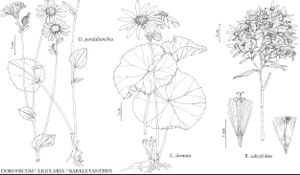Barkleyanthus
Phytologia 27: 407. 1974.
| Taxon | Illustrator ⠉ | |
|---|---|---|
 | Doronicum pardalianches Ligularia dentata Barkleyanthus salicifolius | Yevonn Wilson-Ramsey Yevonn Wilson-Ramsey Yevonn Wilson-Ramsey |
Shrubs, 100–200 [–400+] cm (usually glabrous, sometimes sparsely arachnose or glabrate). Stems usually 1, erect to lax. Leaves cauline; alternate (clustered distally); weakly petiolate; blades weakly 3-nerved, lance-elliptic or lanceolate to lance-linear, margins obscurely dentate to subentire or entire, faces usually glabrous. Heads radiate, in cymiform or paniculiform arrays (crowded in terminal and axillary clusters). Calyculi 0 or of 1–2+ bractlets. Involucres hemispheric or campanulate to weakly turbinate, 5–8 mm diam. Phyllaries persistent, 5–8+ in (1–) 2 series, erect, distinct, elliptic or oblong to obovate, equal, margins ± scarious. Receptacles flat to convex, deeply foveolate (margins of sockets raggedly toothed), epaleate. Ray-florets (3–) 5 (–8), pistillate, fertile; corollas yellow (laminae linear-elliptic). Disc-florets 14–25+, bisexual, fertile; corollas yellow, tubes longer than to equaling narrowly funnelform throats, lobes 5, recurved, lance-linear; style-branches: stigmatic areas continuous, apices ± dilated-truncate. Cypselae ± prismatic to obpyramidal, 5-nerved, strigillose to hirtellous; pappi persistent, of 60–80 (–120), white, barbellulate bristles. x = 30.
Distribution
sw United States, Mexico, Central America
Discussion
Species 1.
Selected References
None.